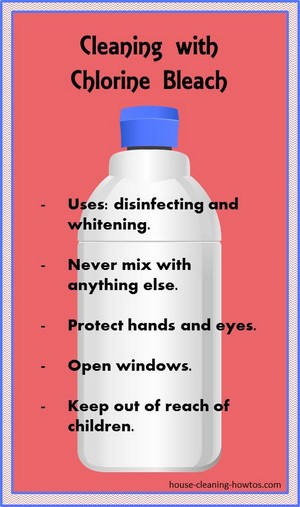
Cleaning with bleach is certainly an effective way to kill germs and whiten your clothes, but it is not without consequences for yourself, your family, and your environment. Learning more about chlorine bleach and other bleach alternatives can help you make intelligent decisions in your choices for household cleaners.
What is Bleach?
Bleach simply refers to a product that lightens the color of things through the action of oxidation. However, most people when they refer to cleaning with bleach are thinking of household-strength chlorine bleach, a solution of sodium hypochlorite manufactured from chlorine.
Non-chlorine bleach is a much milder whitener that can be safely used on colored fabrics to remove stains. It is frequently made with hydrogen peroxide.
Oxygen bleach typically refers to a powdered product made with sodium percarbonate, another whitener that can be used on colored fabrics.
Precautions
- Children: In a house with small children, all cleaning products, including bleach, should be completely out of reach and preferably under lock and key. All cleaners should be clearly marked and it is also advisable to label all of your toxic cleaning products with the number of your poison control center.
- Mixing: Never mix chlorine bleach with other cleaning products, in particular ammonia or anything acidic (such as vinegar). The combination of bleach with these products releases a very toxic gas that can kill you. I believe a general rule of thumb should be to never mix chlorine bleach with anything other than water and don’t forget that mixing can happen on surfaces after you have sprayed on two different products.
- Protection: Always protect your hands when cleaning with bleach. If you don’t wear gloves you are likely to end up with rough, scaly, and even bloody hands – it is that rough on the skin. You may want to use protective eye ware when cleaning with bleach as well.
- Ventilation: Always make sure the area you are using bleach in is well-ventilated – open the windows.
Common Uses for Bleach
Household bleach is used principally as a whitener and as a disinfectant.
Laundry Additive – By adding bleach to your laundry, your white clothes will be whiter and brighter and stains will be easily removed. Bleach will also disinfect your clothes, effectively killing smelly molds.
Always carefully dilute bleach with water before allowing it to come in contact with your clothes. This means that you need to let the washing machine fill with water and a measured amount of bleach (typically 1 cup for a load of white clothes), making sure the solution is well mixed before adding your clothes. Alternatively, you can use a bleach distributor if your washing machine is equipped with one. Find more useful laundry tips here.
Disinfectant – To use household bleach as a disinfectant you will need to dilute it in water. For general cleaning with bleach, use a ratio of 1/4 cup of bleach per gallon of water, or one tablespoon for a quart. That is a 1 to 68 ratio – not very much.
Mix bleach with water and then dip a clean cleaning cloth in it, wring out the excess, and wipe down hard surfaces. You can use this bleach solution without rinsing throughout the kitchen, bathroom, and the rest of the house. Note that some surfaces, especially absorbent ones such as wood, may be harmed by bleach.
Alternatively, you can fill a spray bottle with this solution, but keep in mind that bleach begins breaking down immediately in contact with air and heat, and a new solution must be mixed every day to be effective.
Toilet Bowl – One place I like to use bleach on occasion is in the toilet bowl. Just pour in a 1/2 cup or so, let it sit for 15 minutes, then scrub and flush. Learn more about how to clean a toilet.
Mold – Cleaning with bleach as a mold killer is effective only in some situations. Chlorine bleach will certainly knock the color out of molds, but because you are adding dampness to a surface, you may only be further encouraging mold. On hard non-porous surfaces, chlorine bleach is an effective mold killer, but on something absorbent like wood, you will need to find another solution.
Environmental Questions
Although in the immediate, very toxic and irritating to skin and respiratory systems, chlorine bleach itself weighs in as a fairly good guy on environmental questions.
The manufacturers of bleach like to remind us that their product quickly breaks down into mostly salt and water. The remaining toxicity is then eliminated during the modern processing of sewage. So it would seem reasonable to say that there is no severe harmful impact on the ecosystem from the use of chlorine bleach in the home. However, one could voice concerns about the environmental impact of any manufacturing process which involves the manipulation of dangerous compounds.
There is also some concern these days over a tendency to overprotect ourselves from germs. In our desire to preserve our family’s health, we may rely on such things as bleach for a disinfectant. This reliance could eventually be our downfall as we are encouraging bacteria and viruses to mutate in response to our attack.
Many people recommend a more level-headed approach to cleanliness and health issues, one where we accept that bacteria and viruses are part of the web of life that sustains us. Personally, I limit my use of bleach to an occasional cleaning of the toilet or disinfecting of a cutting board, and certainly don’t rely on it as a cleaner to be used throughout the house on a daily basis.
If you would like more information on these important environmental issues I encourage you to visit the Clorox Bleach Website and read this report entitled Disinfectant Overkill, published by an organization called Women’s Voices of the Earth.
You Might Also Like . . .




